Compensation and Benefits: Essential Concepts Explained
Learn how to build fair, clear compensation and benefits programs that employees trust. Start today and simplify pay decisions for your team.
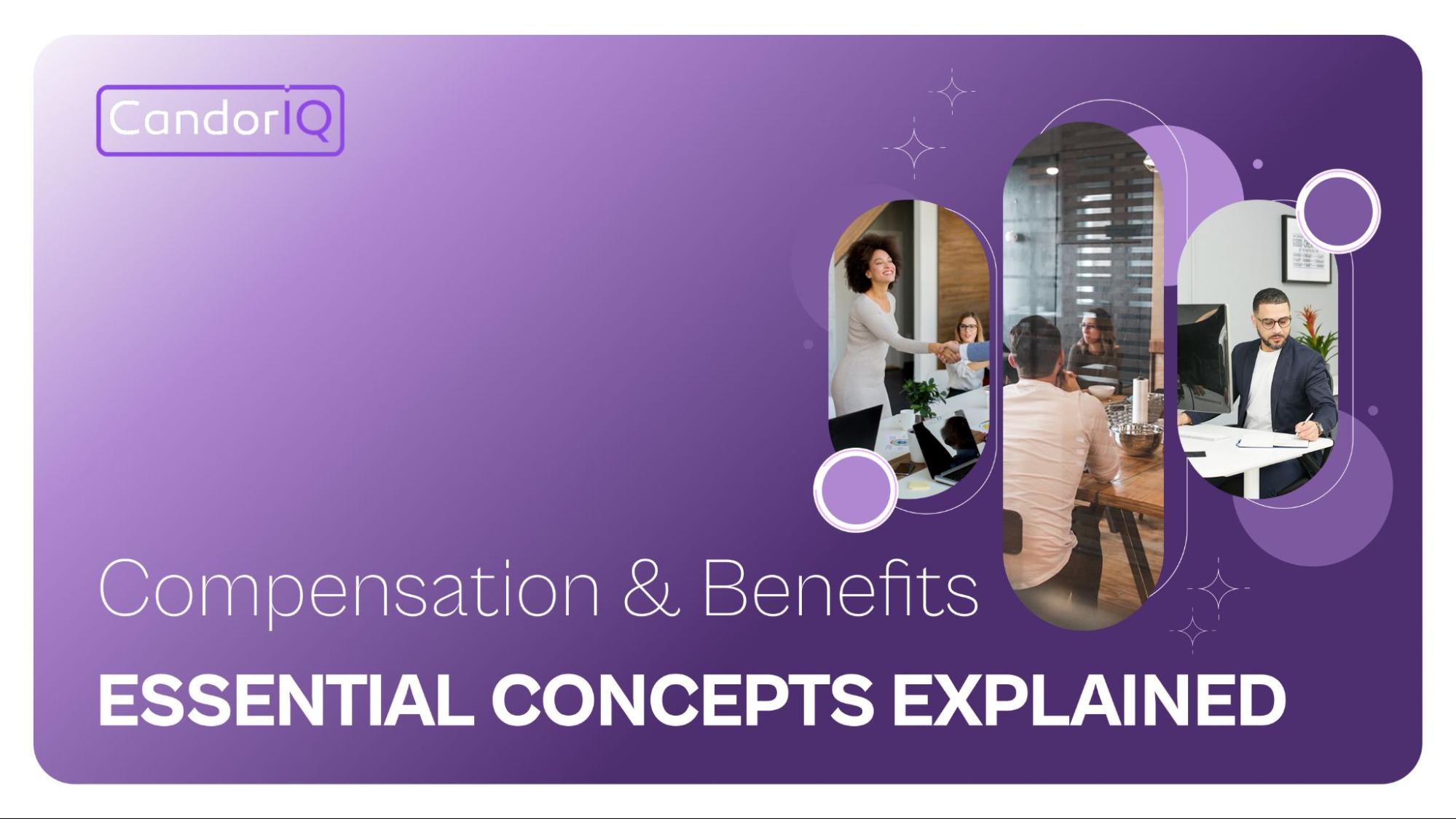
TL;DR
- Compensation = direct pay; benefits = non-cash perks like healthcare, time off, and retirement
- Almost half of employees say salary or bonus is the top reason they stay with a company
- Total compensation includes salary, benefits, and equity, used in hiring and retention decisions
- HR and Finance teams work closely to ensure fair, market-aligned, and budget-conscious rewards
- Metrics like compa-ratio and benefits usage help track effectiveness and equity
Introduction
People don’t leave companies. They leave compensation plans that don’t make sense. Whether it’s unclear salary bands, confusing benefits, or a mismatch between pay and performance, frustration builds fast. Leaders in HR and Finance often carry the pressure of fixing it, usually without a clear roadmap.
Maybe you’ve rolled out a new pay structure, only to be flooded with questions from managers. Or you’ve watched high performers leave while your comp ratios sit just above the 50th percentile. Sound familiar? The stakes aren’t just emotional. They're financial.
In fact, 46% of employees say salary or bonus is the top reason they stay. This isn’t just about spreadsheets and surveys. It’s about designing systems people trust.
In this blog, we’ll break down the essentials of compensation and benefits, what they are, how they work, and why they matter.
What Are Compensation and Benefits?
Before you change anything, it helps to get your definitions straight. Compensation is what you pay employees directly. That includes salary, bonuses, and commissions. Benefits cover the indirect perks like healthcare, PTO, and retirement plans. Together, they shape the full picture of what someone earns.
Total compensation includes:
- Base salary or hourly pay
- Incentives such as bonuses, commissions, or equity
- Health insurance, time off, and retirement contributions
- Extra perks like tuition coverage, wellness programs, or flexible work options
Benefits are often under-communicated, yet they account for a massive portion of total cost. Many employees don’t realize their employer pays thousands each year toward insurance, matching, or leave policies. And many CFOs don’t see the ROI because the value goes unmeasured.
The key takeaway is that compensation and benefits aren’t separate conversations. They work together. And smart leaders look at the full picture when planning, budgeting, and communicating value.
Next up, let’s break down the different types of compensation you’re likely managing today.
Types of Compensation
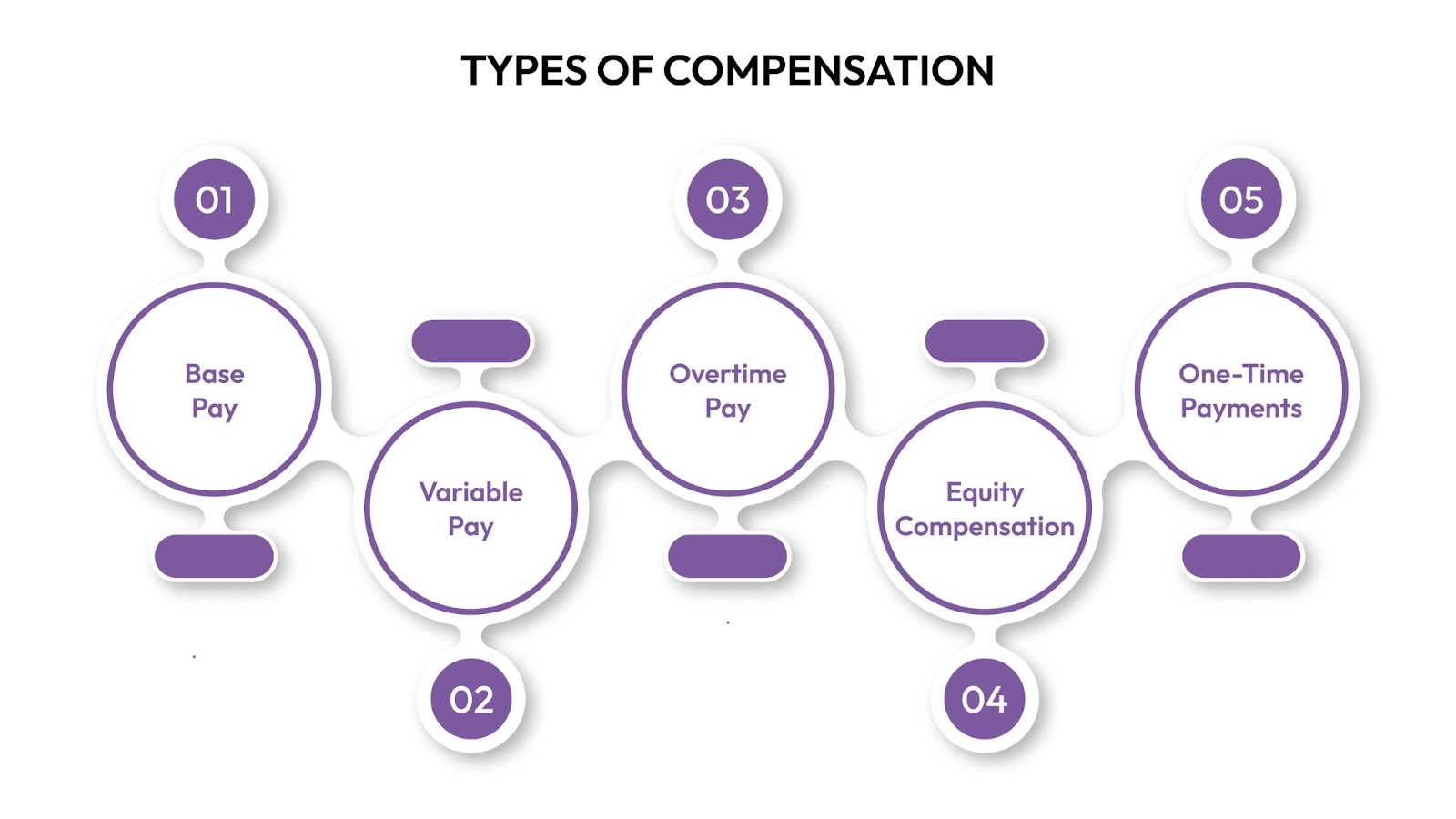
Compensation isn’t just about salary. It covers everything you pay someone for their time, performance, and long-term commitment. Getting it right means understanding how these pieces work together and when to use each one.
Here are the most common types of compensation used in U.S. organizations:
Base Pay
This is the foundation. It’s the fixed salary or hourly wage employees receive, usually tied to job level, location, and market benchmarks. Base pay should be predictable and fair, no surprises, no hidden formulas.
Variable Pay
Bonuses, commissions, and incentive-based pay fall here. These are tied to performance and can vary by role. Salespeople often earn commission, while leadership roles might receive annual bonuses based on company goals.
Overtime Pay
Required under the Fair Labor Standards Act (FLSA), non-exempt employees must be paid 1.5x their regular rate for hours worked beyond 40 per week. Many organizations automate this through payroll systems, but compliance is key.
Equity and Deferred Compensation
These include stock options, restricted stock units (RSUs), and performance shares. Often used in executive or tech compensation, they’re designed to reward long-term value creation. Deferred comp can also refer to pensions or other post-employment payouts.
One-Time Payments
Sign-on bonuses, retention bonuses, and project-based incentives all fall under this bucket. They’re useful for hard-to-fill roles or moments when retention risk spikes.
These elements can be combined in different ways, depending on role, industry, and stage of business. What matters most is clarity. Employees want to know how their pay is structured and what they can influence.
Now that we’ve covered compensation, let’s look at the non-cash side of the equation, benefits.
Types of Benefits
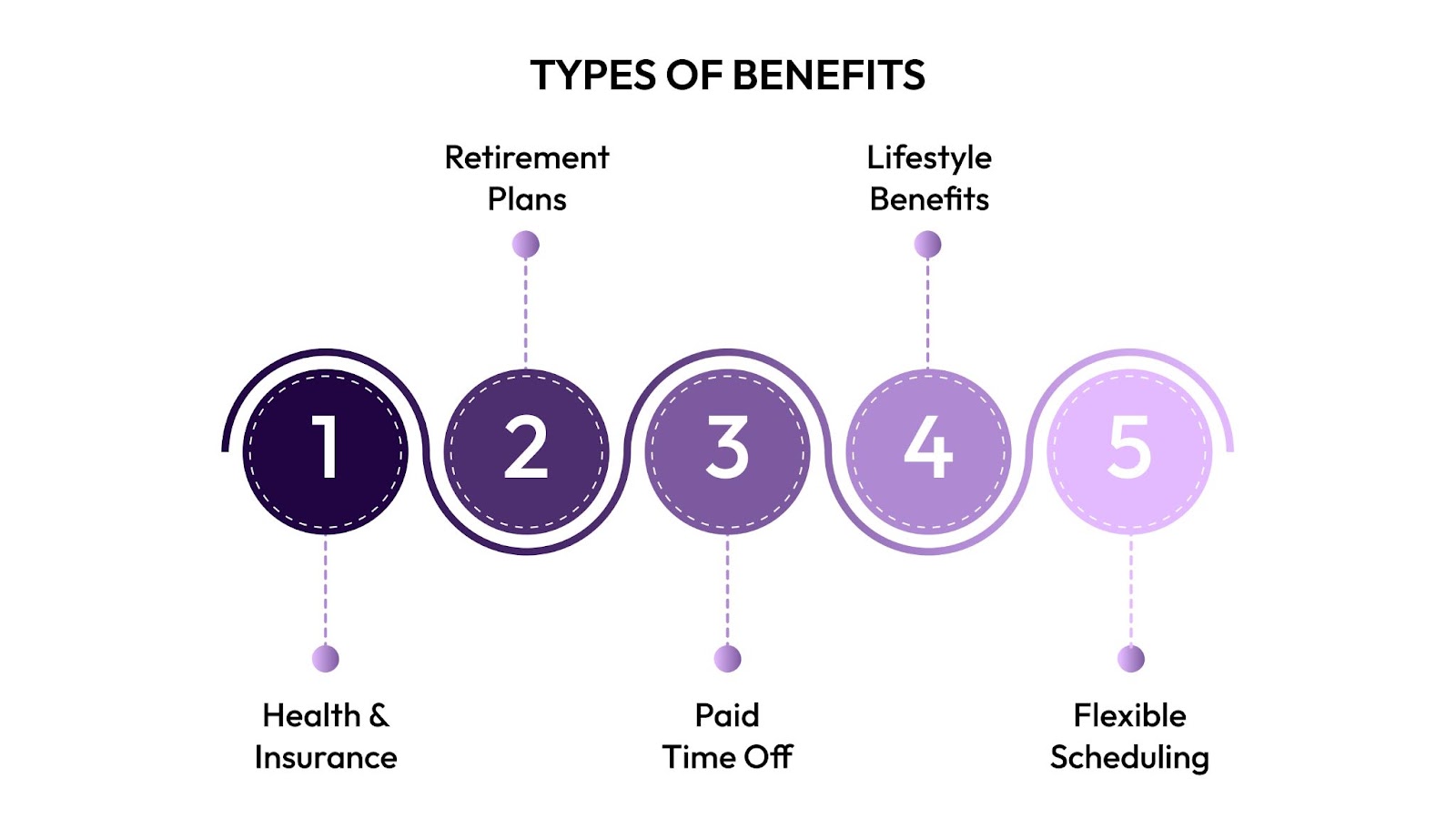
Benefits shape how employees experience your company beyond their paycheck. While compensation gets most of the attention, benefits can drive long-term loyalty and influence everything from well-being to retention.
Here are the core benefit categories most U.S. employers offer:
Health and Insurance
This includes medical, dental, vision, and life insurance. Employers often cover a significant portion of the premiums and offer tiered plans. Mental health coverage and telemedicine are becoming standard expectations.
Retirement Plans
401(k) plans with employer matching remain the most common. Some companies offer pensions or deferred compensation accounts, especially for senior roles. The match percentage and vesting schedule often impact perceived value.
Paid Time Off (PTO)
Vacation, sick leave, holidays, and parental leave all fall under this umbrella. Unlimited PTO policies are becoming more common, though they require strong manager training and usage tracking to be effective.
Lifestyle and Voluntary Benefits
These include wellness stipends, commuter benefits, tuition reimbursement, pet insurance, legal assistance, and identity theft protection. Employees may choose what fits their life stage or goals.
Flexible Work and Schedule Support
Remote work, hybrid options, flexible hours, and compressed workweeks have become key benefits, not just perks. Many candidates treat flexibility as part of compensation when considering a job.
The more you tailor benefits to your workforce, the more value employees perceive. But offering too many unused perks can burn the budget without boosting retention. Tracking usage helps guide what to expand or cut.
Next, we’ll bring everything together under one label: total compensation.
Why Compensation and Benefits Matter?

People talk. About pay. About perks. About fairness. The way you structure and explain your compensation and benefits makes a direct impact on morale, loyalty, and yes, even Glassdoor ratings.
Here’s where it matters most:
Attracting Talent
If your offers don’t match the market, candidates move on. Top talent isn’t just chasing numbers. They’re weighing stability, equity, healthcare, and schedule flexibility. A solid benefits package can win deals where salary falls short.
Retention
Raises aren’t the only way to retain people, but they help. So does transparency. Employees who understand what they’re getting and why are less likely to leave. Feeling undervalued is one of the top reasons people quit.
Engagement and Productivity
When people feel well-compensated, they focus more on the work. When they feel shortchanged, trust erodes. Benefits like mental health support, paid time off, and clear bonus criteria reduce burnout and keep teams steady.
Legal and Financial Risk
Underpaying, misclassifying, or ignoring pay equity laws can lead to penalties and public backlash. Benefits missteps like noncompliance with ACA or ERISA carry real costs. Compensation is about more than fairness. It’s risk management.
Your compensation and benefits plan isn’t a side project. It’s a lever. One that affects recruitment, retention, and the company’s reputation.
Next, we’ll zoom in on HR’s role in building and maintaining that system.
HR’s Role in Compensation and Benefits
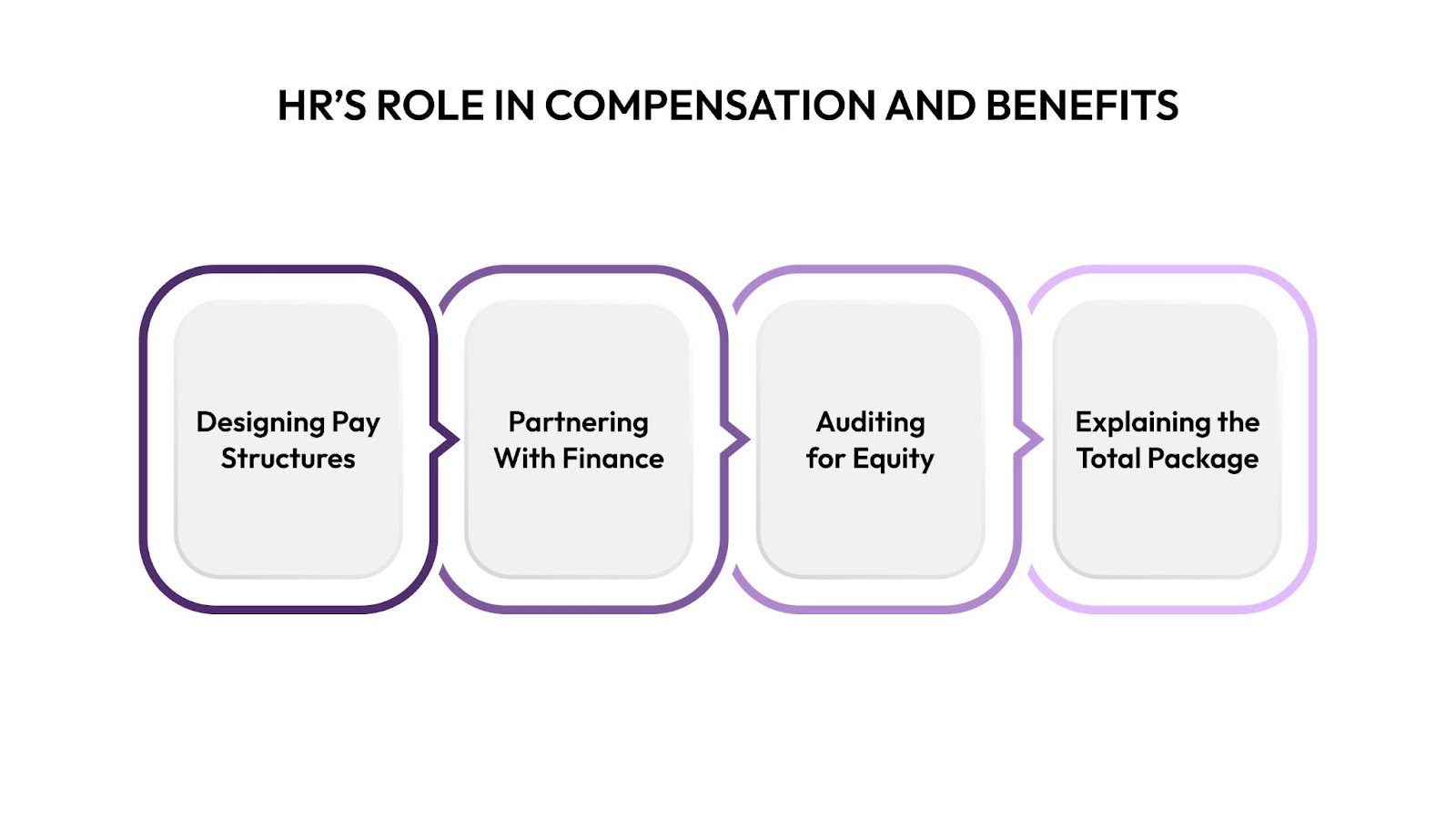
You’re not just setting pay. You’re shaping perception. HR carries the weight of designing comp and benefits plans that are fair, legal, scalable, and clear enough for employees to actually understand.
Here’s where HR plays a central role:
Designing Pay Structures
This includes building salary bands, deciding on job levels, and documenting how progression works. It’s not just about what someone gets paid, it’s about what’s fair across the company.
Partnering With Finance
Every comp decision hits the budget. HR works closely with finance to run cost models, approve headcount plans, and evaluate raises or incentive programs. You need the numbers to make your case.
Auditing for Equity
HR tracks pay gaps across gender, race, and role type. Annual equity audits help flag bias and support fair pay practices. They also prepare the company for transparency laws, which are spreading fast across states.
Explaining the Total Package
You can offer great benefits, but if no one understands them, it doesn’t matter. HR’s job is to explain what employees are getting, how it works, and why it matters whether during onboarding, open enrollment, or compensation reviews.
HR owns the narrative. When people trust the system, they stay. When they don’t, they leave.
Now let’s look at how to measure whether your compensation and benefits strategy is actually working.
Key Compensation Metrics
It’s easy to assume your comp plan is working, until turnover spikes or equity gaps surface. Tracking the right metrics gives HR and Finance a shared view of what’s fair, what’s sustainable, and what needs attention.
Here are four metrics that matter:
Compa-Ratio
This is one of the simplest checks. Take someone’s salary and divide it by the midpoint of their salary band. A ratio of 1.0 means they’re right at market. Below 1.0 means under. Above 1.0? You might be overpaying or rewarding top performance.
This metric helps you compare roles across teams, spot compression, and keep things fair without guessing.
Pay Range Penetration
This tells you how far someone has moved through their salary band. For example, if they’re making $80,000 in a $60,000–$100,000 range, they’re 50% through it.
That percentage matters. It helps with promotion planning, raise decisions, and understanding why someone might feel stuck. Two people earning the same amount can be in very different spots, depending on their band.
Benefits Utilization Rate
This shows how many employees are actually using a benefit. If 200 people are eligible for mental health services but only 30 use them, you’ve got a 15% rate.
This doesn’t always mean the benefit isn’t working. Maybe the program’s buried in a portal. Maybe people don’t trust it. Or maybe it’s just not needed. Either way, low numbers should make you look closer.
Cost of Total Rewards Per Employee
This pulls everything together, from salary, bonus, payroll taxes, insurance, to perks and more. Take the total cost of your people, divide by headcount, and that’s your number.
Finance uses it to model future costs. HR can use it to compare spending across teams or roles. It also helps when you’re making the case for better budgets or defending what you already have.
These numbers won’t solve everything, but they’ll tell you where to look. And when conversations around pay get tough, they give you something solid to stand on.
Next: a quick glossary to help your team speak the same language when compensation questions come up.
Glossary: Terms You Should Know
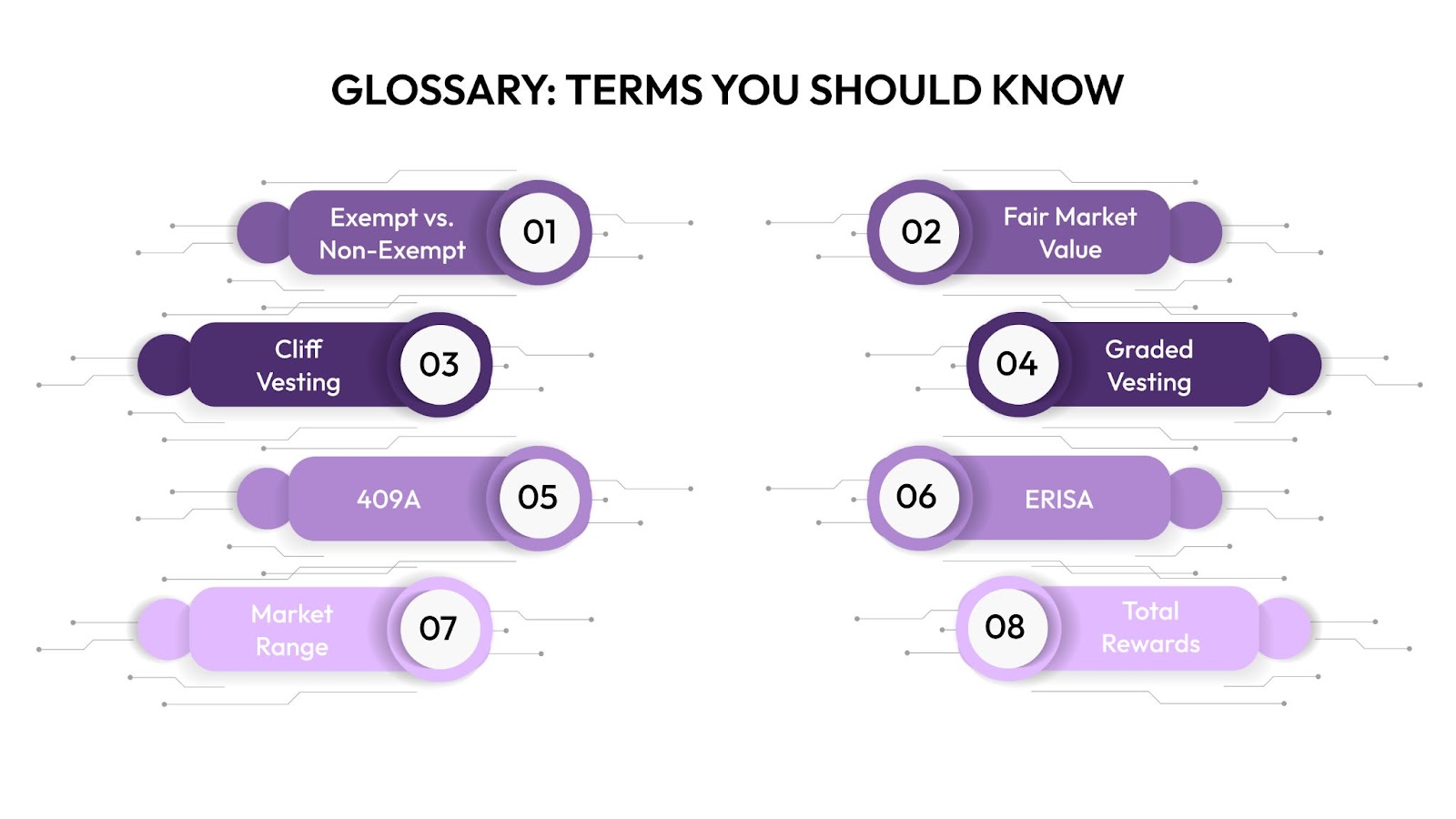
Comp conversations fall apart when people don’t speak the same language. HR says one thing, Finance hears another. This short list clears it up.
Exempt vs. Non-Exempt
Exempt employees aren’t eligible for overtime. Non-exempt employees are. The Fair Labor Standards Act (FLSA) sets the rules. Job duties, not titles, decide who qualifies.
Fair Market Value (FMV)
The going rate for a job in a specific market. It’s used to set pay, evaluate equity, and defend compensation decisions during audits.
Cliff Vesting
This applies to stock or retirement benefits. Nothing is earned until a specific date hits then everything vests at once. Miss the date, get nothing.
Graded Vesting
Instead of all at once, benefits vest gradually. For example, 20% per year over five years. You earn as you go.
409A
A tax code section that applies to deferred compensation. Get it wrong, and employees get hit with extra taxes. It matters most with exec comp and equity plans.
ERISA
The law that covers retirement plans and some benefits. It sets rules on reporting, funding, and fairness. Think 401(k) compliance, not perks like gym passes.
Market Range
The salary span for a job, usually set between the 25th and 75th percentile. Helps you figure out how competitive your pay really is.
Total Rewards
The full package, comp, benefits, perks, flexibility, and anything else with value. It’s what employees look at when they say, “Is this job worth it?”
Clear terms make for cleaner conversations. Especially when people are negotiating offers, asking for raises, or questioning equity.
Now let’s wrap with what matters most: pulling this all together and acting on it.

Conclusion
People care how they’re paid and they notice when it doesn’t add up. Confusion around salary bands, vague bonuses, or slow approvals doesn’t just slow things down. It erodes trust.
CandorIQ gives HR and Finance one place to get it right. Build pay bands, run comp cycles, track headcount plans, and send offers that actually make sense. No guesswork. No disconnected files.
If you’re still chasing spreadsheets and approval chains, there’s a better way. Book a demo. See what clean, fast compensation management feels like.
FAQs
Q: How often should we update our pay bands?
A: Once a year is common, but that’s a floor, not a ceiling. If your market shifts fast, tech, for example review more often. Benchmarking twice a year keeps things accurate.
Q: What’s the difference between total comp and base salary?
A: Base salary is the fixed number on the offer letter. Total comp adds bonuses, equity, benefits, everything someone gets from you. It’s the number people really care about.
Q: Do we need different pay bands for different locations?
A: Yes, if you’re hiring across regions. A role in San Francisco won't pay the same as one in Kansas City. Location-based bands help keep things fair and realistic.
Q: How do we know if someone is underpaid?
A: Start with their compa-ratio. If it’s far below 1.0, take a closer look. Compare against peers in the same band and check how long they’ve been in-role.
Q: What’s the best way to explain benefits during offers?
A: Keep it simple and visual. Use total comp summaries that show dollar values for healthcare, equity, bonuses, everything. People don’t value what they don’t understand.


